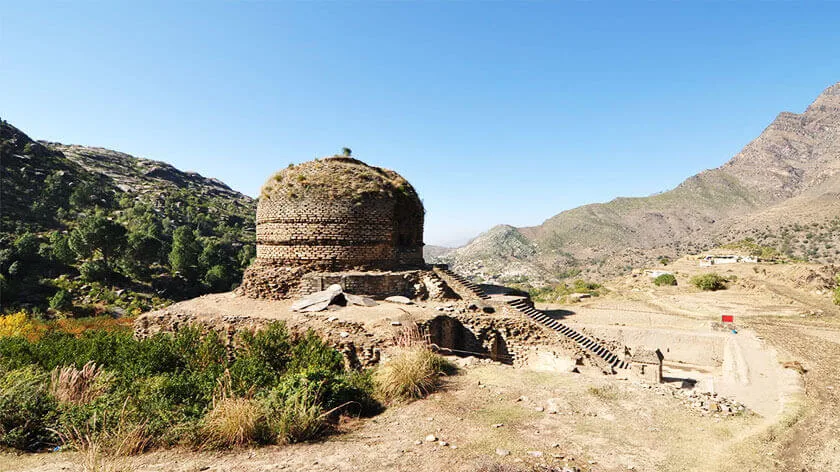Monuments of Swat Valley
Swat was one of the most important centers of
Gandhara civilization. Besides the Gandhara civilization, many other
civilizations have been nurtured in the lap of Swat.
Maharaja Ram Chandar Jee, a holy figure of
Hindus, enshrined in the Elam Mountain of Swat and made it sacred for the
followers of Hinduism.
It is said that traditions of the greatness and
sanctity of Elam Hill are also found in books of Zoroastrians, Persians and
Greeks. In the holy book of Hindus, "Rig Veda", the river flowing
here is called "Swastu".
It had been a province of Persian king Darius
I, who was conquered by Alexander the Great in 327 BC. In 305 BC it came under
the possession of Mauryan dynasty of India. About 55 years later, the Parthian
nation took possession of said territory.
In the 1st century AD, the Gandhara
civilization came under the control of Kushanas, who were nomads from Central
Asia. In 7th century AD, "Padma Sumbawa" (Second Buddha)
left for Tibet from Swat region.
During these times, the Swat region was
considered a holy land, being the source of East Asian Buddhism, and pilgrims
from Tibet, China and other places regularly came to visit it.
Dr. Luca Maria, a renowned Italian
archaeologist, spent 27 years in Swat Valley serving as the head of Italian
Archaeological Mission. He is considered to be the most authoritative scholar
and researcher of Odhiana (the old name of Swat) in the present day.
Classifying archeology of Swat, the heritage is
great, vast and amazing. Its classification is difficult, but we can say that it
is one of the fifty most important archaeological sites in the world. Ancient
books and Chinese records clearly describe some of them.
Odhiana is considered a part of Gandhara.
According to some researchers, Odhiana was a separate kingdom. Apart from the
paradise of this valley, its ancient Buddhist monuments are of great
importance. Stupas, monasteries, residential buildings, forts and numerous rock
curving valleys are scattered throughout the valley.
These monuments in Swat Valley are still the
center of attraction for tourists. But the people here as well as the
government do not fully understand their importance due to which these monuments
are disappearing rapidly.
According to archeologists, not even 10% of the
artifacts have been discovered in Swat so far. Valuable relics from various
places in Swat, including Buddha statues, coins, period vessels, ornaments and
other valuables, were earlier kept in Sidhu Sharif Museum, but this is no
longer the case and has been stopped for many years.
Mauza Jahanabad Mangalore is the world's second
largest rock carving in Swat, which was irreparably damaged during Taliban era.
On 11th and 23rd September 2007, an attempt was made to
detonate his head with explosives, which the Italian mission later tried to
prevent from further damage.
Also, wherever the remains of Buddhist era are
scattered across the expanses of Swat, a few are under the watchful eye of Italian
Mission and the rest face the irony of the situation. Most are still illegally
mined by smugglers, while the rest are stoned and littered by children, old and
young.
The archeology of Swat is not only under threat
from the general public, but the archeology department is equally involved in
their plight and bringing them to this state.
People have been misled. That is why they stone
these monuments etc. Although it has been clearly stated in the Holy Quran that
bad words should not be used for the places of worship of other religions.
Unfortunately for us, 250 smuggler groups are
using all kinds of tactics to use these artifacts for their personal gain.
Ironically, they have both government and public support.
Until the government officials take strict
notice of this process, the smugglers are not caught, their supporting elements
are not punished, and then these monuments cannot be stopped from being
destroyed.
Illegal mining is still going on in several
areas of Swat such as Brikot, Panjigram, Kanjar Koto, Nangrial, Panar, Kokaria,
Baligram, Kabal, Khawaza Khela, Matta, Shokhdara and even Gul Kada (which is a
government-held area).
Apart from this, large-scale illegal
excavations are also taking place in major archaeological centers including
Kota Abuha, Shamuzu, Jalala, Garodagai, Banjot and Taligram areas.
Valuable items are extracted from these places
which are smuggled to Thailand, Japan, America, and European countries. This
illegal work involves the Department of Archeology, local police and many
government agencies and even local influential political figures.
The Department of Archeology is responsible for
destruction of archeology in Swat. All the organizations that work in Swat to
protect the archeology, these monuments are in danger.
All the monuments in Swat, whether they are
ruins, Swat's only museum or sculptures, etc., are at the mercy of Italian
Mission to protect and restore them. Till date the Department of Archeology has
not done even a penny of work in Swat.
In 2012, a few smugglers were caught during
illegal excavations at the Amluk Dara site (Tehsil Brikot Swat). Even the
'Buddha Sattva' was recovered from them which was later made a part of Swat
Museum. These smugglers were later released after minor sentences and fines.
There is a need for the government to legislate
well against the traffickers and their accomplices to save these archeological
sites which are a great destination for visitors and a good source of income
for the country.
Also visit:
👉 Bashigram Lake of Madyan Swat Valley
👉 Beautiful Places to visit in Neelum Valley
👉 Hunza Valley of Gilgit-Baltistan | Tourist Paradise
👉 Top 10 Most Beautiful Places in Pakistan





Please share your experience in Comments Box, if you visited any Tourist Place in Pakistan.